Customer acquisition: strategy, channels and metrics
Nov 17th, 2021

Contents
What is customer acquisition? Customer acquisition funnel
Customer acquisition strategy
Customer acquisition channels
Customer acquisition cost and metrics
Next step: customer retention
The process of acquiring new customers is one of the most essential and complicated tasks for any business. Every day brands face different challenges while striving for successful customer acquisition. In today’s world, consumers see about 10,000 ads per day, so it isn’t easy to draw attention to your company and make it visible in the crowded market. Moreover, public trust in advertising has dropped significantly from 50% in the 1990s to 25% in present days. As a result, it becomes more challenging for the brands to get the messages across to their target audience. The solution to these problems is to develop a strong customer acquisition strategy.
Building a strategy that allows your company to bring in new clients regularly is the best path to prosperity. The detailed customer acquisition plan would cover the necessary expenses, the ways to generate demand, and the most reliable methods of converting visitors into paying clients. Thus, the perfect customer acquisition strategy should be cost-effective, integral, dynamic, and systematic. We will describe how to develop the plan and put it into practice.
What is customer acquisition? Customer acquisition funnel
Customer acquisition refers to the process of attracting new customers for your business or turning current prospects into new customers. Acquiring clients is encouraging them to buy the company’s products or services. The process covers the overall buyer’s journey starting from building awareness and the first contact through the conversion process to the paying customer. The main aim of the activity is to develop a structured long-term acquisition plan that can adapt to changing trends and conditions while communicating your long-term brand positioning. The major steps of customer acquisition strategy include attracting, converting, closing, and retaining clients.
The stages of customer acquisition strategy can be presented as a customer acquisition funnel. The customer acquisition funnel is a model used for tracking and monitoring the effectiveness of getting new customers and building customer loyalty. The model helps visualize the customer’s journey and understand what you can improve in the process to achieve the best results.
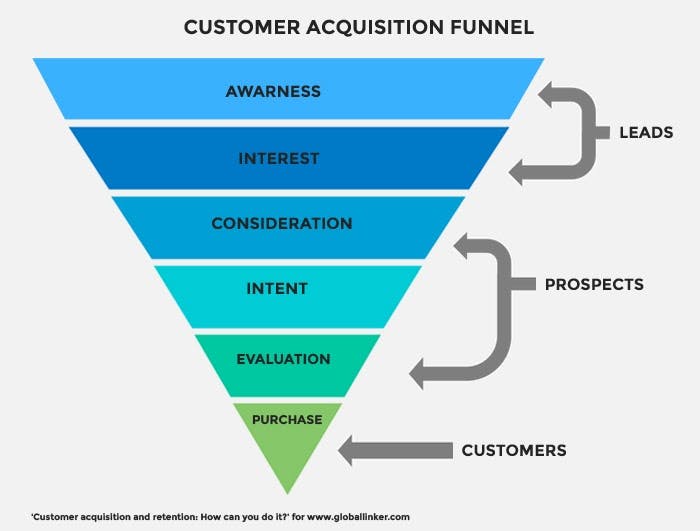
The customer acquisition funnel includes the following stages:
- Awareness. The prospects learn about the brand for the first time due to marketing activities or discover the information by themselves.
- Interest. The brand educates the customers about the offers by using emotionally or rationally resonating messages.
- Consideration. The customers familiarize themselves with the products by visiting the company’s website, reading the articles, and registering for a free trial.
- Intent. The prospects watch video tutorials and product demos and add the products to the shopping cart on the website.
- Evaluation. The brand analyzes the customers’ reactions and encourages them to take further steps and buy the product. At this stage, some prospects consider similar options by studying the advantages and disadvantages of the other brands.
- Purchase. At the final stage of the funnel, the prospects turn into paying customers. The brand uses the opportunities for upselling, cross-selling, or rewarding loyal clients.
You can take a look at our article on AIDA model, to see a slightly different way to approach this process.
Customer acquisition strategy
A customer acquisition strategy is a roadmap that will help you find a product-market fit, win new customers, and turn prospects into buyers and active users of your product or service. We will consider the basic steps, which are the essential points of every successful customer acquisition strategy.
1. Define your audience
The first stage in developing a customer acquisition plan is to create a buyer persona or a detailed description of the ideal customer. If you are trying to reach different audiences, you need to develop a separate strategy for each group. You need to take into account the customers’ demographic data, problems, needs, goals, interests, and behavior. Then you can apply the other methods, such as conducting the market research, analyzing the information from the competitors, and identifying social trends to understand the clients’ requirements better.
2. Determine the objectives
The next step is to establish the objectives and think of what you would like to accomplish with your marketing efforts. For example, your goals might include promoting your product or brand to a specific audience, converting the online traffic into phone calls, encouraging people to complete a form, inviting potential customers to your physical location, or turning prospects into buyers.
3. Choose the most suitable channels
Decide what customer acquisition channels would be the most effective for your business and target audience. There are various online and offline methods of reaching customers, including content marketing, social media platforms, referrals, and paid advertising. We will describe the customer acquisition channels in greater detail in the next section of this article. But, if you’re looking for a more detailed and refined selection of the channels most applicable to your business, you can engage a marketing consultant to help you.
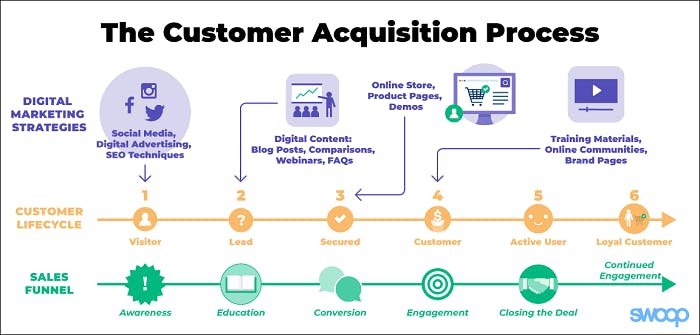
4. Make a financial plan
Plan the budget dedicated to customer acquisition. Decide on how much risk you are willing to take. Your risk tolerance will influence the investment strategy and the amount of money you are ready to put into the unpredictable expansion of the customer base. There is also a chance that a budget that both fits your risk threshold and financial opportunities would not deliver the expected results.
5. Optimize the process
Optimization should be a continuous procedure. Therefore, it is necessary to regularly measure the effectiveness of your advertising campaigns to have a clear picture of the channels and methods which deliver the best results. Thus, you will be able to remove the campaigns that are not producing the desired outcomes, increase the performance of the most effective ones and address any issues that you will discover during the monitoring phase.
Lead nurturing is an important part of the customer acquisition process. Many prospects will not convert after the first contact, so you’ll have to continue communication and work with them to build your credibility before converting them into customers.
Now we will review some of the most popular channels for customer acquisition and the ways you can leverage these resources for your business.
Customer acquisition channels
Customer acquisition channels are places where your clients first encounter your brand. Once you have defined your target audience, it is time to determine where the customers spend time and how to reach your buyer personas.
Content marketing
Determine which pages on your site generate the most organic search traffic, such as blog articles. Then analyze the keywords with the help of Google Search Console and make a list of the most popular queries. This list will help you better understand the most interesting topics for the visitors and generate the content plan according to their preferences.
You can partner with the other brands and create the content which will be promoted on both websites. Pay attention to the businesses that target a similar audience. The original and unique content is your guarantee of success. Moreover, by creating unique and factual content pieces, you can reach the media and get publications in specialized industry magazines. Engage a content strategist in your activities to ensure the success of content marketing activities.
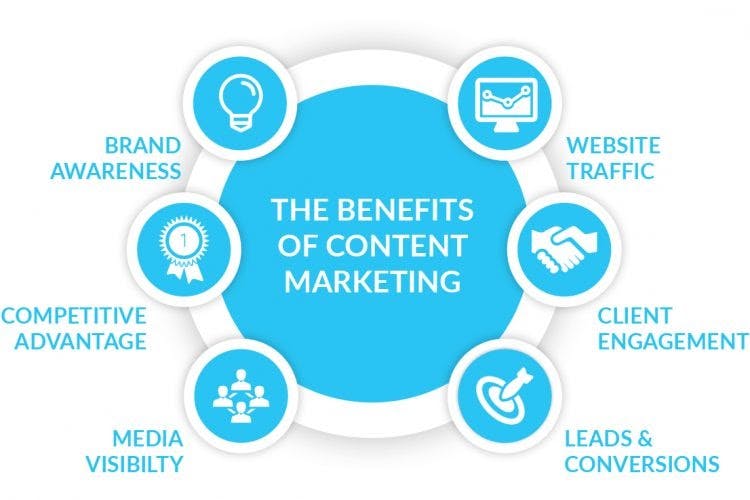
Organic search
Organic traffic has an immense potential for your brand as the visitors coming to your website are ready to buy the product. There are several different ways to increase organic search traffic. The first method is to generate traffic from the existing content on your blog. As the older articles usually have lower rankings in search results, you can review, update articles with relevant changes and republish the blog articles after changing the date to the current day. This will move the posts to the first page of the blog and improve their ranking. Then you can share the posts on social media and other platforms and gain additional backlinks.
Add the keywords related to locations and industries you want to reach. Create the content relevant to the industry or location you are targeting, add case studies and testimonials, suitable imagery, and use the keywords both in the title tag and page’s URL. You can also make a list of the areas where you want to target customers, build landing pages for each and develop a hub page with links to all the places. The next step is to consider the journey that visitors to the page would take to convert.
Social media
People often use social media to find information about the brand, so you can turn your pages into the critical points of your conversion funnel. Publish viral posts worth sharing to increase your website traffic. Monitor social media platforms for keywords, such as industry terms, company name, specific products or location to acquire leads before they run a search. Use the promoted posts to engage with potential clients. Social media platforms also provide the opportunity to create unique and compelling brand stories to share your company’s values and mission. Many brands post user-generated content on social media pages to build trust with the customers and encourage them to make purchasing decisions. Brand partnerships and influencer marketing are the other ways to use social media in your acquisition strategy.
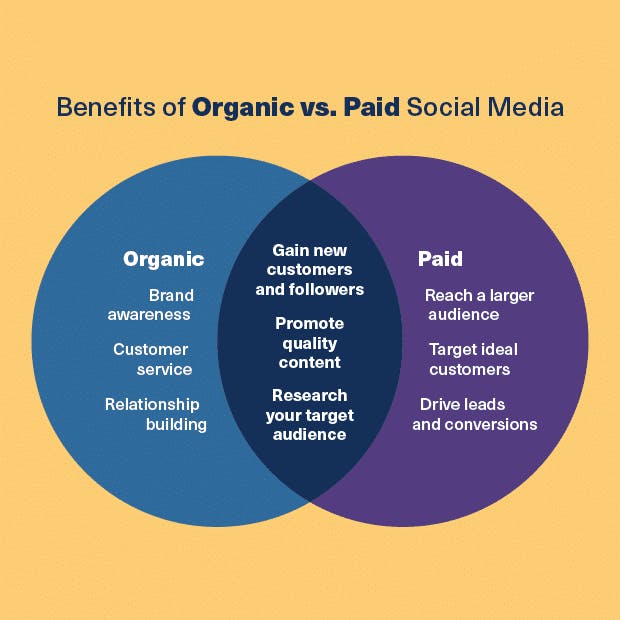
Paid social
Marketing specialists use paid social to attract new customers and increase conversion. In the first case, the primary goal is to get more subscribers on the social media platforms, familiarize them with your company and encourage the customers to buy your product or service. You can achieve this objective by telling the clients about the key product features and advantages. If your goal is to increase conversion, it can be realized through remarketing. To turn your subscribers into buyers, you need to tell them about the products or services in greater detail, describe new features, benefits, and specific characteristics. If you want to involve the existing clients, upselling would be a good option.
Referrals
Customer referrals can improve your brand’s image and engage new customer audiences. The perfect way to implement referral programs is to involve a large number of affiliates to maximize profit. If you are going to launch the influencer campaign, you need to focus on partnering with the industry leaders who will promote your product. You can also integrate your product with another brand’s product and pay for each signup. The main points for consideration related to the referral program include the sum of payout for affiliates, the system for tracking referrals, the types of compensation (per click or signup), and the people who would be interested in being your affiliates.
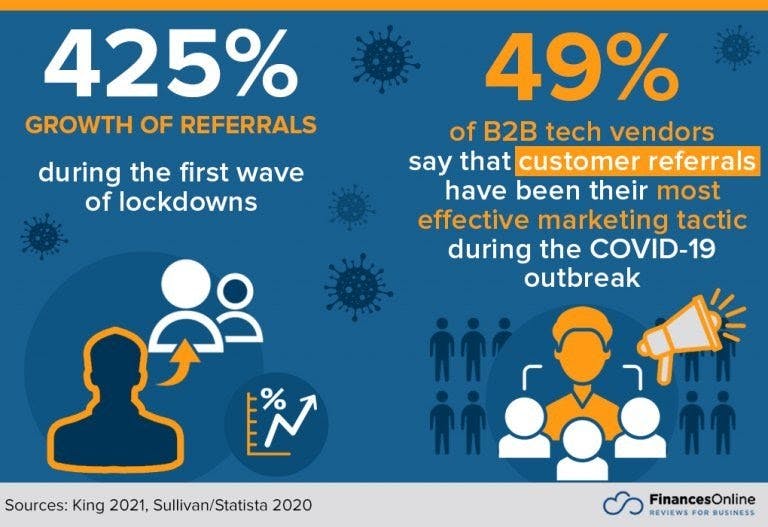
The other way to implement a referral program is to encourage the existing customers to bring more potential clients. Satisfied customers will recommend the product to their family and friends and invite them to join the platform.
Email marketing
Email marketing is a great tool to boost revenue, increase traffic volume to your website, and a direct way to get in touch with customers. Emails give you plenty of opportunities to promote your business. You can tell your brand story, explain your values, show the product demos, or present successful examples. Furthermore, emails will be useful for client retention in the future.
To keep customers engaged, you need to match the target audience’s expectations and deliver value simultaneously. For example, you can create unique content that would be available only to email subscribers. If you segment the customers into groups and provide the pieces of information according to their preferences and interests, you would meet the clients’ requirements.
Once you have defined the appropriate channels for customer acquisition, you can calculate the cost to plan your marketing budget.
Customer acquisition cost and metrics
We will describe the formula of convincing the potential client to make a purchase and review the most relevant metrics, including conversion rate, visits to specific pages in the process, and cost by channel.
Customer acquisition cost is one of the most critical of the product marketing metrics. You can determine the customer acquisition cost by dividing all expenses dedicated to attracting new clients by the number of customers acquired for the same period of time. The marketing and sales expenses usually include advertising, salaries of the team, bonuses and commissions, the cost of content production, cost of software used or developed in order to conduct these activities, and overall costs for sales and marketing over the defined period.
The first step in calculating customer acquisition cost is to determine the specific time range you are researching. Then you need to summarize total marketing and sales costs during this time period.
The CAC formula is as follows:
CAC = Sales Expenses / Number of New Customers Acquired

You can also calculate customer acquisition costs by channel. This will enable your business to determine the most cost-effective method of acquiring clients and the channels worth investing in.
There are two ways of calculating CAC by channel. The first method is to use averages, assuming that each channel provides the same number of customers. In this case, you need to divide the total expenses by the number of channels. The second way is based on the touch attribution model. According to this model, the conversion is attributed to the channel the customer interacted with last before making a purchase.
Conversion rate represents the efficiency of converting the leads into customers through your marketing and sales efforts. This metric is crucial for coordinating the work of your sales and marketing teams as they will use it to evaluate lead quality. The conversion rate is the proportion of conversions made to the total number of clicks registered. There are three methods to calculate the conversion rate:
Conversion Rate = Total number of conversions / Total number of sessions * 100
Conversion Rate = Total number of conversions / Total number of leads * 100
Conversion Rate = Total number of conversions / Total number of unique visitors * 100
Rate of visits to specific pages is a method of estimating interactions with potential consumers early in the buying process. This metric will help you analyze the effectiveness of the landing pages and understand what should be improved.
Cost by channel identifies which marketing channels are effective in attracting new customers and at what cost. It allows you to optimize the strategy by determining what channels show poor performance and eliminating them. To calculate the cost by channel, you need to divide the expenses on this specific channel by the number of customers acquired from this channel.
Next step: customer retention
Customer acquisition is only the first step for creating a successful business. It is critical to retain as many new clients as possible and build strong customer relationships. An excellent retention strategy will help you boost loyalty and turn the customers into brand ambassadors. Thus, developing a solid retention strategy is a critical extension of the customer acquisition strategy once you start getting active customers.
